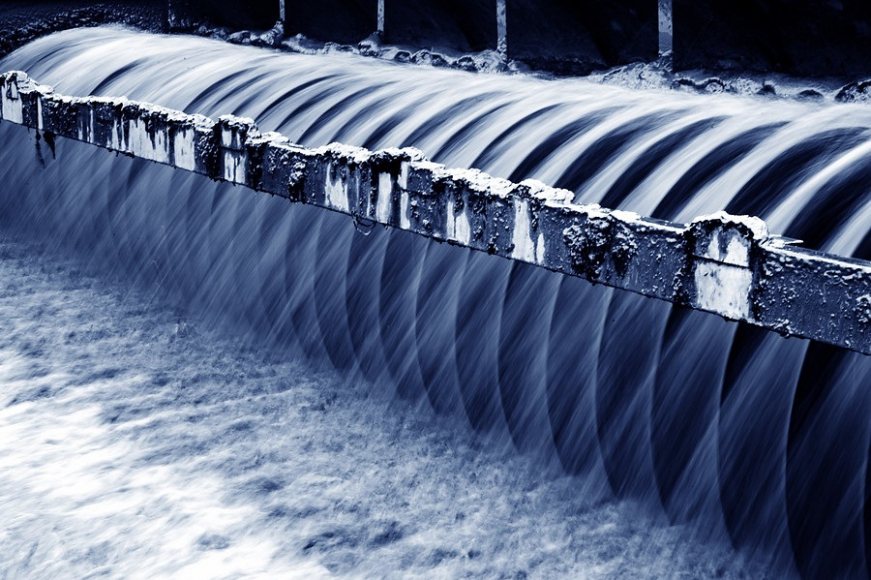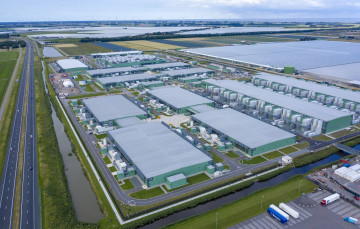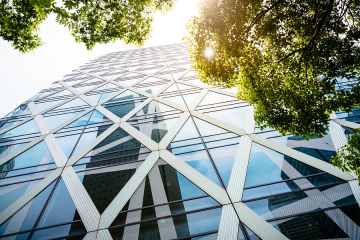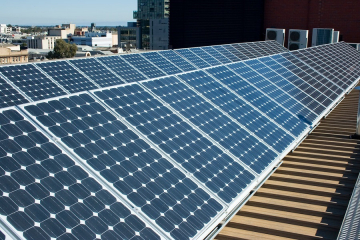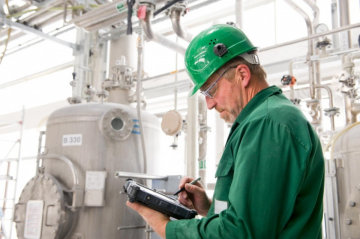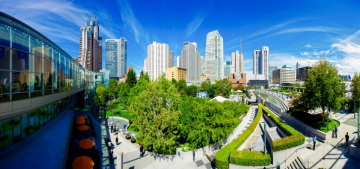Over the past few months, we’ve provided guidance and resources on how to identify, properly scope out, and implement facility optimization projects. We also looked at raising the sustainability bar by considering solar energy. With this blog, we complete our facility optimization series by discussing water. More specifically, how it’s used, how to establish its true cost and how to conserve it.
“We never know the worth of water till the well is dry.” ― Thomas Fuller
Understand How Much Water You Are Using
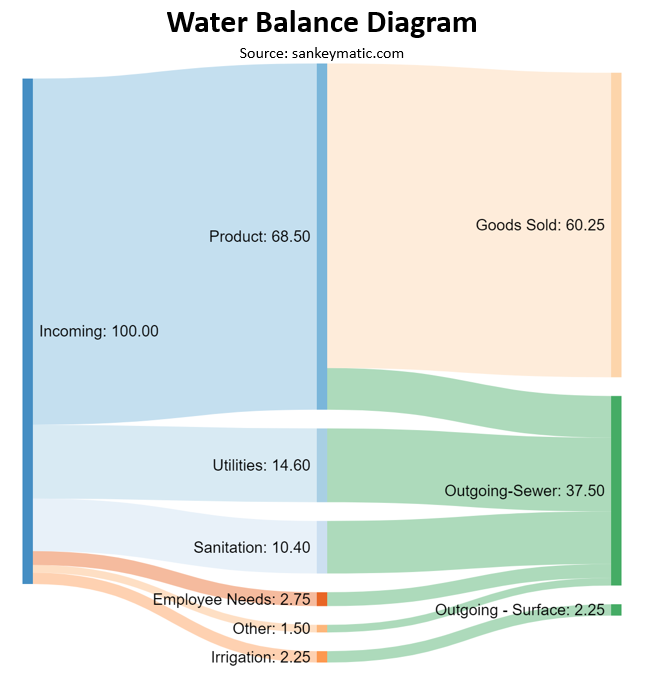 The first step in water saving practices is to determine why and how water is being used. A simple water balance diagram like the one shown here can help you visualize how water is sourced, used and discharged at your facility. You can start by gathering the water bills from the past 12 months – for both incoming (withdraw) and outgoing (discharge) water. If you have well water or other sources of water, collect the usage and cost of those too. Same for the outgoing water, if you discharge water to a stream, determine the quantity. Is there a cost to maintain a permit to discharge the water to the stream? If so, gather that cost.
The first step in water saving practices is to determine why and how water is being used. A simple water balance diagram like the one shown here can help you visualize how water is sourced, used and discharged at your facility. You can start by gathering the water bills from the past 12 months – for both incoming (withdraw) and outgoing (discharge) water. If you have well water or other sources of water, collect the usage and cost of those too. Same for the outgoing water, if you discharge water to a stream, determine the quantity. Is there a cost to maintain a permit to discharge the water to the stream? If so, gather that cost.
With the bills collected, enter date, usage quantity, and cost, into a spreadsheet. Compare the quantity of incoming water with the quantity of discharged water -- do they match? If not, investigate why and make a note of it.
Next, walk through your facility and gather information on how the water is used once it enters the building. The most common categories of water usage are:
- Production
- Utilities
- Sanitation
- Employee Needs
- Irrigation
- Other Uses (industry-specific)
If you don’t have precise numbers, from a water sub-meter for example, estimate the usage to the best of your knowledge. One good method is using the equipment specifications to determine the quantity of water needed to operate the equipment. Remember, you do not need perfect numbers to make this a valuable effort.
Establish the True Cost of Water
Traditionally, the cost of water is calculated using the incoming water bill plus the sewer water bill. However, these costs may only represent 25-50 % of the true cost of water for a facility, especially a manufacturing facility. Water used for production, utilities, and sanitation, are usually chemically treated, heated or cooled, and maybe even filtered. The cost of the treatment chemical, and energy used to heat, cool, and pump the water could be 2-4 times as much as the incoming water and sewer bills.
The basic concept is to consider the embedded costs as water enters a particular process or gets discharged into a sewer drain or as wastewater effluent. Each treatment, heating, cooling, and filtering process adds to the overall water expense.
The cost of incoming and outgoing water should be readily available on the bills. However, the cost of each use of water at your facility, can be a bit more complicated – so here is a handy data collection workbook that we’ve developed to help you get started.
You’ll want to account for:
- Incoming Costs (water supply)
- Treatment Costs (chemicals, filtration, etc.)
- Electrical Energy Costs (cooling, pumping, transporting the water)
- Natural Gas Energy Costs (heating, steam generation)
- Discharge Costs (sewer fees, wastewater treatment)
- Regulatory Costs (permits, compliance management, penalties)
- Maintenance Costs (pump seal replacement, cooling tower re-sealing, pump and motor shaft alignment, etc.)
After gathering this information and calculating the costs for each water use category, the true cost can be determined. Note that it’s not unusual to see the cost to condition the water to be 50-75% of the total water cost, as the costs associated with filtering, chemically treating and heating/cooling processes can be significant.
Prioritize Water Conservation
Once you understand how water is used and how much that water really costs, you can focus on water savings efforts. The following are areas to consider for water conservation projects:
Meter Readings
Typically, water companies invoice their customers every three months. Although this reduces the administrative work to process the bills, it has an unintended side effect. If you have a leaky irrigation line underground, for example, it could be three months before it’s discovered when the water bill arrives. Make it a practice to read and record the water meter usage on a daily basis. Track water usage in a spreadsheet as it will allow you to catch any irregular water usage sooner than the quarterly billing cycle.
Leaks and Overflow
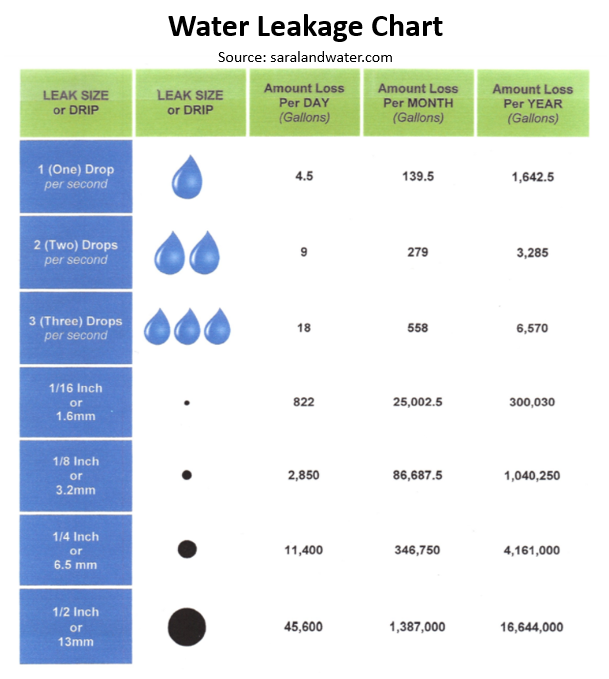 This applies to all categories of water use. Leaks typically occur at the pipe connection point, at the pumps, the water container (such as a cooling tower basin overflow), or the end use devices (such as water source heat pump). Leaks can be costly as illustrated in this chart. For a more specific estimate of the amount of water lost due to leaks at your facility, place a bucket under the leak to catch the water for an hour. Measure the quantity of water captured in 15-minute intervals, then calculate the water lost over an annual basis. Then use the true cost analysis completed previously, to determine the savings of fixing leaks.
This applies to all categories of water use. Leaks typically occur at the pipe connection point, at the pumps, the water container (such as a cooling tower basin overflow), or the end use devices (such as water source heat pump). Leaks can be costly as illustrated in this chart. For a more specific estimate of the amount of water lost due to leaks at your facility, place a bucket under the leak to catch the water for an hour. Measure the quantity of water captured in 15-minute intervals, then calculate the water lost over an annual basis. Then use the true cost analysis completed previously, to determine the savings of fixing leaks.
Best practice guidance for manufacturing plants recommend implementing a "dry floor policy." When floors are wet, it is usually an indication that something is not normal -- for instance, a leak. In some instances, wet floors may be anticipated -- like with sanitation or cleaning. Regardless, wet floors require attention for safety reasons.
Water Pressure
Higher than required water pressure results in unnecessary water use, exacerbates leaks, and causes excessive wear and tear on equipment. Install pressure reducing valves where it makes sense to match water pressure needed for the end use. Accurate calculation of the water lost due to higher than necessary pressure is complex; however, we can still use the bucket method to estimate how much water is leaking at different pressures. Simply measure the time it takes to fill water to a certain quantity at current pressure, reduce the pressure, then measure again.
Reduce Undesirable Heat Loss
Just like waiting for the shower to warm up before you hop in, the same situation applies at industrial facilities. Use the water balance exercise you completed and determine where water needs to be at a certain temperature before it can be used. To reduce the amount of water lost to the drain, insulate the supply pipes to maintain water at the desired temperature as much as possible. In addition, check and see if it’s possible to lower the supply water temperature. You can estimate how much water is lost to drain before it reached the desired temperature by adding a thermometer to the bucket and timing technique.
Irrigation
Landscape watering can be optimized by using moisture sensors, weather station-controlled irrigation systems, adjusting the time of watering to reduce evaporation lost, and minimizing overspread. Work with your landscape contractors to calculate water savings potentials by implementing these solutions.
Employee Use
There are opportunities to save water in restrooms, kitchens, and showers in gyms. Install low flow devices where applicable. High efficiency and/or dual flush toilets and waterless urinals, all have been used successfully to reduce water use. The process to estimate savings has a few steps, but its relatively simple. Use online tools such as this EPA calculator or look for resources provided by water fixture manufactures or your local water utility company.
In an industrial setting, there are many sophisticated water savings techniques, such as: countercurrent rinsing, upgrading sprayers/jets, adopting turbidity probes, using conductivity to determine water purity, syncing-up water shut-off to production line activity, re-using wash water, using cleaning-in-place technology, etc. These techniques and equipment can reduce water use significantly. However, their applicability is site and process specific and should be evaluated with a qualified engineer that understands your specific needs.
Lastly, water conservation is encouraged by many water utility companies. Check with your local water supplier for applicable incentives and performance recognition programs. Keep in mind, some water savings projects will also result in energy savings. Electric and gas utility companies may also provide incentives.
Conclusion
Using the water balance technique to determine the true cost of water informs not only how water is used but also the risk related to business operations in the event of a water supply interruption. We all know that water is a limited resource and businesses must do what they can to manage the costs and risks associated with it. Having a better understanding of the true cost of water at your facility is an important first step toward greater water stewardship and business resiliency. It is also a project that is incredibly low effort and high reward. Determining your true cost of water is something that can be done remotely, cost-effectively and using commonly available data.
Antea Group’s Facility Optimization Ebook
Download Antea Group’s ebook to learn strategies that will optimize the sustainability and business resiliency of your facilities and assets.
DownloadIf you have questions or would like assistance with Facility Optimization support, or Water Stewardship services, contact us today.
Want more news and insights like this?
Sign up for our monthly e-newsletter, The New Leaf. Our goal is to keep you updated, educated and even a bit entertained as it relates to all things EHS and sustainability.
Get e-NewsletterHave any questions?
Contact us to discuss your environment, health, safety, and sustainability needs today.


